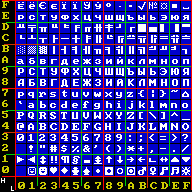Related Research Articles

ArmSCII or ARMSCII is a set of obsolete single-byte character encodings for the Armenian alphabet defined by Armenian national standard 166–9. ArmSCII is an acronym for Armenian Standard Code for Information Interchange, similar to ASCII for the American standard. It has been superseded by the Unicode standard.

Code page 850 is a code page used under DOS operating systems in Western Europe. Depending on the country setting and system configuration, code page 850 is the primary code page and default OEM code page in many countries, including various English-speaking locales, whilst other English-speaking locales default to the hardware code page 437.
The Kamenický encoding, named for the brothers Jiří and Marian Kamenický, was a code page for personal computers running DOS, very popular in Czechoslovakia around 1985–1995. Another name for this encoding is KEYBCS2, the name of the terminate-and-stay-resident utility which implemented the matching keyboard driver. It was also named KAMENICKY.

Code page 866 is a code page used under DOS and OS/2 in Russia to write Cyrillic script. It is based on the "alternative code page" developed in 1984 in IHNA AS USSR and published in 1986 by a research group at the Academy of Science of the USSR. The code page was widely used during the DOS era because it preserves all of the pseudographic symbols of code page 437 and maintains alphabetic order of Cyrillic letters. Initially this encoding was only available in the Russian version of MS-DOS 4.01 (1990), but with MS-DOS 6.22 it became available in any language version.
Windows-1257 is an 8-bit, single-byte extended ASCII code page used to support the Estonian, Latvian and Lithuanian languages under Microsoft Windows. In Lithuania, it is standardised as LST 1590-3, alongside a modified variant named LST 1590-4.
Code page 775 is a code page used under DOS to write the Estonian, Lithuanian and Latvian languages. In Lithuania, this code page is standardised as LST 1590-1, alongside the related Code page 778.
Mac OS Ukrainian is a character encoding used on Apple Macintosh computers prior to Mac OS 9 to represent texts in Cyrillic script which include the letters ‹Ґ› and ‹ґ›, including the Ukrainian alphabet.
MacGreek encoding or Macintosh Greek encoding is used in Apple Macintosh computers to represent texts in the Greek language that uses the Greek script. This encoding is registered as IBM code page/CCSID 1280 and Windows code page 10006.
Code page 773 is a code page used under DOS to write the Estonian, Lithuanian and Latvian languages.
Code page 912 is a code page used under IBM AIX and DOS to write the Albanian, Bosnian, Croatian, Czech, English, German, Hungarian, Polish, Romanian, Serbian, Slovak, and Slovene languages. It is an extension of ISO/IEC 8859-2, though prior to 1999, the code page matched ISO/IEC 8859-2 exactly.
Code page 915 is a code page used under IBM AIX and DOS to write the Bulgarian, Belarusian, Russian, Serbian and Macedonian but was never widely used. It would also have been usable for Ukrainian in the Soviet Union from 1933 to 1990, but it is missing the Ukrainian letter ge, ґ, which is required in Ukrainian orthography before and since, and during that period outside Soviet Ukraine. As a result, IBM created Code page 1124. It is an extension of ISO/IEC 8859-5. The original code page matched ISO/IEC 8859-5 directly.
Code page 1118 is a code page used under DOS to write the Lithuanian language. It was previously standardised in Lithuania as LST 1283.
The GEM character set is the character set of Digital Research's graphical user interface GEM on Intel platforms. It is based on code page 437, the original character set of the IBM PC.
Mac OS Sámi is a character encoding used on classic Mac OS to represent the Sámi languages and the Finnish Kalo language. While not used in any official Apple product, it has been used in various fonts designed to support Sámi languages under classic Mac OS, including those from Evertype. FreeDOS calls it code page 58630.
Mac OS Maltese/Esperanto, called MacOS Esperanto in older sources, is a character encoding for Esperanto, Maltese and Turkish created by Michael Everson on August 15 1997, based on the Mac OS Turkish encoding. It is used in his fonts, but not on official Mac OS fonts.
Code page 921 is a code page used under IBM AIX and DOS to write the Estonian, Latvian, and Lithuanian languages. It is an extension of ISO/IEC 8859-13. The original code page matched ISO/IEC 8859-13 directly.
Mac OS Armenian is an Armenian character encoding for Mac OS created by Michael Everson for use in his fonts. It is not an official Mac OS character set.
Code page 778 is a code page used under DOS to write the Lithuanian language. It is a modification of code page 775 to support the accented Lithuanian letters and phonetic symbols for Lithuanian. This code page is also known as LST 1590-2.
LST 1564:2000 is a character encoding used to write the Lithuanian language. It is a modification of ISO/IEC 8859-13 to support the accented Lithuanian letters.
References
- ↑ "Rašmenų koduotės". Lietuvių kalba informacinėse technologijose.
- ↑ "Cpi/CPIWIN/Codepage.TXT at master · FDOS/Cpi". GitHub .
- ↑ "LST 1590-4". Rašmenų koduotės. Retrieved 2020-06-14.